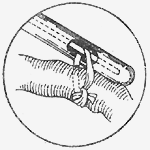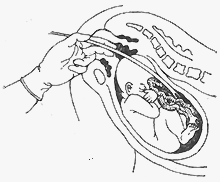| disease | Umbilical Cord Prolapse |
| alias | Prolapse of Cord |
If the fetal membranes have ruptured and the umbilical cord further prolapses below the presenting part of the fetus, passing through the cervix into the vagina, or even protruding through the vagina to the vulva, it is called umbilical cord prolapse. When the umbilical cord is located in front of or to the side of the presenting part of the fetus and the fetal membranes are intact, it is called umbilical cord presentation. Umbilical cord presentation is essentially a grade I umbilical cord prolapse, also known as occult umbilical cord prolapse.
bubble_chart Etiology
Various reasons can cause difficulty in the fetal head entering the pelvis, such as a narrow pelvis or cephalopelvic disproportion; abnormal fetal positions, such as breech presentation, shoulder presentation, occiput posterior position, brow position, etc.; excessively long umbilical cord; polyhydramnios, etc. When artificial rupture of membranes or spontaneous rupture of membranes occurs, the umbilical cord is prone to prolapse.
bubble_chart Clinical Manifestations
Umbilical cord presentation or prolapse has little impact on the mother, only increasing the rate of surgical delivery. However, it is very harmful to the fetus. In cases of umbilical cord presentation or prolapse where the fetal presenting part has not yet entered the pelvis and the membranes are intact, the fetal presenting part may be forced to descend only during contractions, and the umbilical cord may be temporarily compressed, leading to abnormal fetal heart rate. If the fetal presenting part has already entered the pelvis and the membranes have ruptured, the umbilical cord may be compressed between the fetal presenting part and the pelvis, causing fetal hypoxia. The fetal heart rate will inevitably change, and may even disappear completely. This is most severe in cephalic presentation and least severe in shoulder presentation. If the umbilical cord blood circulation is interrupted for more than 7-8 minutes, the fetus will die in utero.
bubble_chart DiagnosisIn the presence of risk factors for umbilical cord prolapse, vigilance for actual prolapse is essential. If the membranes are intact and there is a sudden deceleration of the fetal heart rate following fetal movement or uterine contractions, which rapidly recovers upon changing the mother's position, pushing up the presenting part, or elevating the hips, the possibility of occult umbilical cord prolapse should be considered. Fetal heart rate monitoring should be performed after labor begins. Monitoring methods can be chosen based on available resources; during delivery, fetal heart rate can be monitored using a fetal monitor, Doppler ultrasound, or stethoscope, and fetal biophysical profile can be assessed to understand the fetal condition. B-mode ultrasound can also be used to help determine the position of the umbilical cord, and a vaginal probe can provide clearer images. Extra caution is required if the membranes have ruptured. If abnormalities in the fetal heart rate are detected, a vaginal examination should be performed immediately to check for umbilical cord prolapse and to assess whether the umbilical vessels are pulsating. Care should be taken not to apply excessive pressure during palpation to avoid delaying treatment and exacerbating compression of the umbilical vessels. The diagnosis is confirmed if the umbilical cord is palpated beside or below the presenting part, within the vagina, or if the cord is prolapsed outside the vulva.
bubble_chart Treatment Measures
Once umbilical cord prolapse or descent is detected, and the fetal heart rate is still present, or although there are variations but not completely disappeared, or has just suddenly disappeared, it indicates that the fetus is still alive. The fetus should be delivered within a few minutes. If the cervix is fully dilated and the fetal head has entered the pelvis, forceps delivery or vacuum extraction should be performed immediately. For breech presentation, if the technique of breech extraction is mastered, breech extraction should be performed. For shoulder presentation, if the techniques of internal version and breech extraction are mastered, they can be performed immediately. The latter two are easier to perform if the patient is a multipara. If there is uncertainty about performing breech extraction, especially for primiparas, a cesarean section should still be performed. If the cervix is not fully dilated, a cesarean section should be performed immediately. During the preparation period, the patient should be placed in a head-down, breech-up position. If necessary, the presenting part should be manually pushed above the pelvic inlet to relieve cord compression. The operator's hand should remain in the vagina to prevent the presenting part from descending further, thereby relieving cord compression. The umbilical cord should be disinfected and then reinserted into the vagina.
For occult cord prolapse with intact membranes and good uterine contractions, the patient should be placed in a head-up, breech-down position (side-lying or supine), and the fetal heart rate should be closely monitored. If the fetal head enters the pelvis and the cervix gradually dilates while the fetal heart rate remains good, vaginal delivery can be attempted. For footling breech or shoulder presentation, a cesarean section should be performed.If the cervix is not fully dilated, the fetal heart rate is good, and there are no conditions for a cesarean section or the patient and family do not consent to a cesarean section, umbilical cord replacement can be attempted. There are several methods for umbilical cord replacement. A common method is to place the patient in a head-down, breech-up position, use an anal tube with an enlarged side hole, insert a metal strip inside, and lightly tie a disinfected gauze strip to the lower part of the prolapsed umbilical cord. Then, at the side hole of the anal tube, insert the metal strip into the loop of the gauze strip (Figure 1), and then insert the anal tube into the bottom of the uterine cavity, allowing the prolapsed umbilical cord to be reinserted into the uterine cavity with the anal tube. Subsequently, first withdraw the metal strip, then withdraw the anal tube, leaving the umbilical cord and the tied gauze strip above the presenting part. Carefully listen to the fetal heart rate and closely monitor whether the umbilical cord prolapses again. If the umbilical cord replacement is successful, the patient should be quickly transferred to a hospital with the necessary conditions for a cesarean section or induction of labor. Before performing umbilical cord replacement, the presenting part should be pushed up to prevent cord compression. Since the success rate of umbilical cord replacement is not high, the patient and family should be informed before the procedure. If the fetal heart rate has been absent for more than 10 minutes and intrauterine fetal death is confirmed, the family should be informed, and the patient should be allowed to deliver naturally through the vagina. To avoid perineal laceration, craniotomy can be performed.
|
|
|
Figure 1: Umbilical Cord Replacement for Prolapsed Cord
For patients with the presenting part of the fetus not engaged in the pelvis during the clinical stage, heightened vigilance is required, and rectal or vaginal examinations should be minimized or avoided. Fetal heart monitoring should be performed after membrane rupture. If artificial membrane rupture is necessary, a high-level membrane rupture should be performed to prevent umbilical cord prolapse during the outflow of amniotic fluid.






